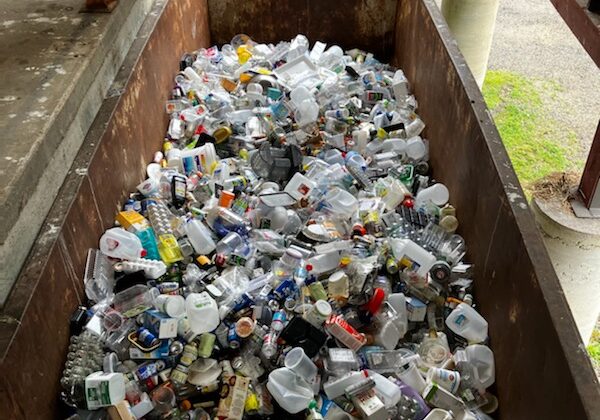Matt Riiska Talks Trash
Text By Kelly Kandra Hughes
Photo By Heath Hughes
Historically, Connecticut has done well with its garbage. As a state, it buries the least amount of trash in landfills. “But now it’s going to get ugly quick,” said First Selectman Matt Riiska to a group attending his talk about trash at the Norfolk Hub on June 6.
As Riiska explained, Materials Innovation and Recycling Authority (MIRA) in Hartford is the vendor the town uses to dispose of its municipal solid waste (aka trash). After July 1, they will no longer incinerate waste for energy; instead, they will ship Norfolk waste to two landfills in Ohio and one in Mississippi. “How that’s cost effective, I have no idea,” said Riiska. When he investigated the two Ohio landfills further, he found that one has a capacity for eight more years of trash and another has 12 years. “If we don’t do something pretty quickly here, what are we going to do with all this garbage we’re creating?” he asked.
How to reduce waste was the central theme in Riiska’s talk. The statistics for municipal solid waste in Norfolk are startling. The town averages 775 tons per year. In the 2017 fiscal year, the price for MIRA to accept the town’s garbage for disposal was $72 per ton. This fiscal year it is $105 per ton—with an expected increase in the next few years to $125 per ton. These prices also do not take into account hauling the waste to the MIRA facilities, which costs an additional $27 per ton.
Bulky waste, such as construction materials and old furniture, is another part of the trash equation. On average, Norfolk produces 320 tons of bulky waste per year, with costs currently at $127 per ton for acceptance and $60 per ton for hauling (although the town uses a separate vendor for bulky waste).
These statistics additionally don’t consider recycling. For paper, glass and plastic, the town produces around 160 tons per year. Riiska explained that the town receives no financial compensation for recycling; it is factored in as part of MIRA’s business model to offset some of their costs. The cost to haul the recycling falls to the town and we currently pay $118 per ton for removal.
Riiska made clear that there are environmental benefits to recycling, but it’s not a long-term solution for the sheer amount of waste disposed of at the Norfolk Transfer Station. “Of all of the plastic that’s recycled,” said Riiska, “8 percent gets used again.”
When given the opportunity to talk to Governor Ned Lamont last month, Riiska wanted to talk trash. “We have to do something,” Riiska told Lamont. “We can’t let this keep going like this. We’re a little town and we’re basically producing 1,200 tons of garbage a year that’s going nowhere.” The governor recommended contacting the Commissioner of Energy and Environmental Protection, which Riiska has on his agenda.
In the meantime, some solutions are being considered. Riiska encouraged people to start at the top with their purchasing and ask questions such as “do I really need this item or can I buy it used or borrow it from a friend or neighbor?” He also encouraged everyone to use the two new textile recycling bins at the transfer station. Clothes, shoes and accessories can all be dropped into the bins. In addition to these textiles not going into the waste stream, the town receives $100 per ton.
Also discussed was a “pay-as-you-throw” option, where only specifically colored garbage bags purchased from the town could be tossed into transfer station bins. Users would then be limited to what they can throw away and, theoretically, be forced to use less. This method has been used in other New England towns, and “it’s effective,” said Riiksa, although an audience member did express concerns that people might start illegally dumping their trash. Riiska conceded that was a potential problem and that people have to make an effort to be better.
Having a food scrap collection site at the transfer station was another solution discussed. Riiska identified a few people in town who are actively pushing for it to become a reality and he hopes the town will be able to offer one eventually. Logistics are a primary concern and there are state regulations that need to be followed. “We’re going to see what we can do,” said Riiska, who then reiterated his main message about waste reduction. “It’s about how much can we take out so we can reduce that cost.”

